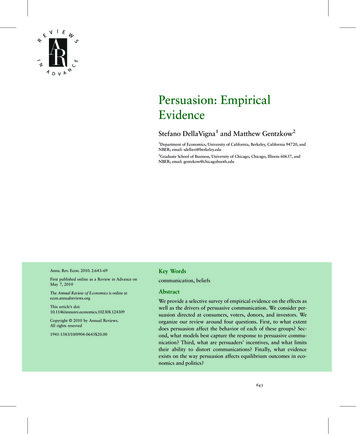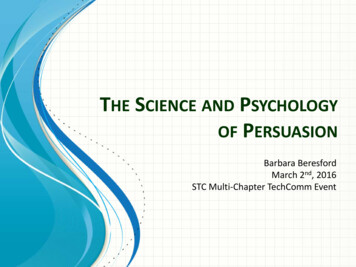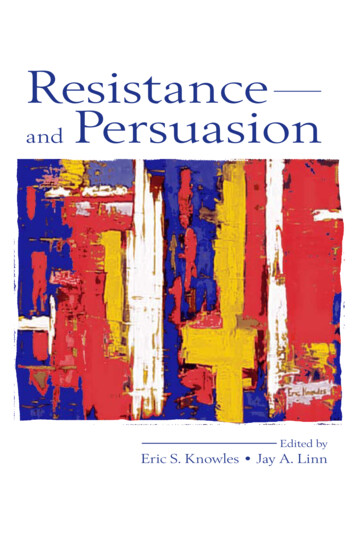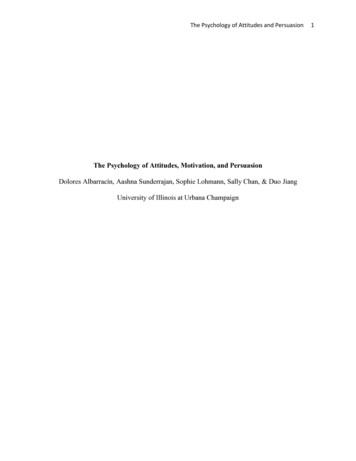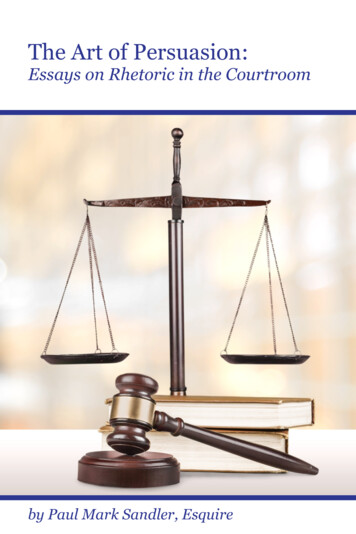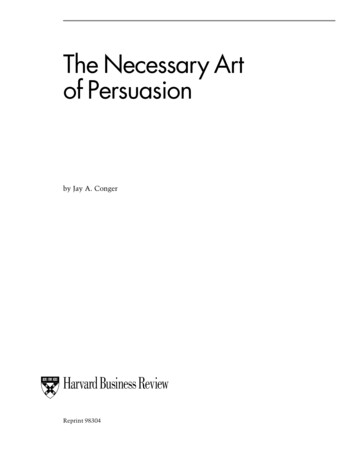
Transcription
The Necessary Artof Persuasionby Jay A. CongerHarvard Business ReviewReprint 98304
HarvardBusinessReviewMAY– JUNE 1998Reprint NumberDAVID J. COLLIS ANDCYNTHIA A . MONTGOMERYCREATING CORPORATE ADVANTAGE98303JAY A . CONGERTHE NECESSARY ART OF PERSUASION98304CHRIS ARGYRISEMPOWERMENT:THE EMPEROR’S NEW CLOTHES98302JEFFREY PFEFFERSIX DANGEROUS MYTHS ABOUT PAY98309M AHLON APGAR , IVTHE ALTERNATIVE WORKPLACE:CHANGING WHERE AND HOW PEOPLE WORK98301ORIT GADIESH ANDJA MES L . GILBERTPROFIT POOLS:A FRESH LOOK AT STRATEGY98305ORIT GADIESH ANDJA MES L . GILBERTm anager’s to ol kitCONSTANTINEVON HOFFM ANHBR CASE STUDYGORD ON SHAW,ROBERT BROWN,and PHILIP BROMILEYideas at workL ARRY E. GREINERHBR CL ASSICHOW TO MAP YOUR INDUSTRY’S PROFIT POOLDOES THIS COMPANY NEED A UNION?STRATEGIC STORIES:HOW 3M IS REWRITING BUSINESS PLANNINGEVOLUTION AND REVOLUTION ASORGANIZATIONS GROWJEFFREY E. GARTEN98306983119831098308BO OKS IN REVIEWOPENING THE DOORS FOR BUSINESS IN CHINA98307
The language of leadership is misunderstood, underutilized –and more essential than ever.T H E N E C E S S A RY A RT O FP E R S UA S I O NBY JAY A. CONGER
f there ever was a time for businesspeople to learn the fine artIof persuasion, it is now. Gone are the command-and-control days ofexecutives managing by decree. Today businesses are run largely bycross-functional teams of peers and populated by baby boomers andtheir Generation X offspring, who show little tolerance for unquestioned authority. Electronic communication and globalization havefurther eroded the traditional hierarchy, as ideas and people flow morefreely than ever around organizations and as decisions get made closerto the markets. These fundamental changes, more than a decade inthe making but now firmly part of the economic landscape, essentiallycome down to this: work today gets done in an environment where
t h e n e c e s s a ry a r t o f p e r s ua s i o nT welve Year s of Watching and ListeningThe ideas behind this article spring from three streamsof research.For the last 12 years as both an academic and as aconsultant, I have been studying 23 senior businessleaders who have shown themselves to be effectivechange agents. Specifically, I have investigated howthese individuals use language to motivate their employees, articulate vision and strategy, and mobilizetheir organizations to adapt to challenging businessenvironments.Four years ago, I started a second stream of researchexploring the capabilities and characteristics of successful cross-functional team leaders. The core of mydatabase comprised interviews with and observationsof 18 individuals working in a range of U.S. and Canadian companies. These were not senior leaders as inmy earlier studies but low- and middle-level managers. Along with interviewing the colleagues of thesepeople, I also compared their skills with those of otherpeople don’t just ask What should I do? but Whyshould I do it?To answer this why question effectively is to persuade. Yet many businesspeople misunderstandpersuasion, and more still underutilize it. The reason? Persuasion is widely perceived as a skill reserved for selling products and closing deals. It isalso commonly seen as just another form of manipulation – devious and to be avoided. Certainly, persuasion can be used in selling and deal-clinchingsituations, and it can be misused to manipulatepeople. But exercised constructively and to its fullpotential, persuasion supersedes sales and is quitethe opposite of deception. Effective persuasion becomes a negotiating and learning process throughwhich a persuader leads colleagues to a problem’sshared solution. Persuasion does indeed involvemoving people to a position they don’t currentlyhold, but not by begging or cajoling. Instead, itinvolves careful preparation, the proper framing ofarguments, the presentation of vivid supportingevidence, and the effort to find the correct emotionalmatch with your audience.Jay A. Conger is a professor of organizational behavior atthe University of Southern California’s Marshall Schoolof Business in Los Angeles, where he directs the Leadership Institute. He is the author of Winning ’Em Over:A New Model for Managing in the Age of Persuasion(Simon & Schuster, 1998).team leaders – in particular, with the leaders of lesssuccessful cross-functional teams engaged in similarinitiatives within the same companies. Again, my focus was on language, but I also studied the influence ofinterpersonal skills.The similarities in the persuasion skills possessedby both the change-agent leaders and effective teamleaders prompted me to explore the academic literature on persuasion and rhetoric, as well as on the art ofgospel preaching. Meanwhile, to learn how most managers approach the persuasion process, I observed several dozen managers in company meetings, and I employed simulations in company executive-educationprograms where groups of managers had to persuadeone another on hypothetical business objectives.Finally, I selected a group of 14 managers known fortheir outstanding abilities in constructive persuasion.For several months, I interviewed them and their colleagues and observed them in actual work situations.Effective persuasion is a difficult and timeconsuming proposition, but it may also be morepowerful than the command-and-control managerial model it succeeds. As AlliedSignal’s CEOLawrence Bossidy said recently, “The day whenyou could yell and scream and beat people into goodperformance is over. Today you have to appeal tothem by helping them see how they can get fromhere to there, by establishing some credibility, andby giving them some reason and help to get there.Do all those things, and they’ll knock down doors.”In essence, he is describing persuasion – now morethan ever, the language of business leadership.Think for a moment of your definition of persuasion. If you are like most businesspeople I haveencountered (see the insert “Twelve Years of Watching and Listening”), you see persuasion as a relatively straightforward process. First, you stronglystate your position. Second, you outline the supporting arguments, followed by a highly assertive,data-based exposition. Finally, you enter the dealmaking stage and work toward a “close.” In otherwords, you use logic, persistence, and personalenthusiasm to get others to buy a good idea. The reality is that following this process is one surefireway to fail at persuasion. (See the insert “Four WaysNot to Persuade.”)What, then, constitutes effective persuasion? Ifpersuasion is a learning and negotiating process,then in the most general terms it involves phases ofCopyright 1998 by the President and Fellows of Harvard College. All rights reserved.art work by David Johnson
t h e n e c e s s a ry a r t o f p e r s ua s i o ndiscovery, preparation, and dialogue. Getting readyto persuade colleagues can take weeks or months ofplanning as you learn about your audience and theposition you intend to argue. Before they even startto talk, effective persuaders have considered theirpositions from every angle. What investments intime and money will my position require from others? Is my supporting evidence weak in any way?Are there alternative positions I need to examine?Dialogue happens before and during the persuasion process. Before the process begins, effectivepersuaders use dialogue to learn more about theiraudience’s opinions, concerns, and perspectives.During the process, dialogue continues to be a formof learning, but it is also the beginning of the negotiation stage. You invite people to discuss, even debate, the merits of your position, and then to offerhonest feedback and suggest alternative solutions.That may sound like a slow way to achieve yourgoal, but effective persuasion is about testing andrevising ideas in concert with your colleagues’ concerns and needs. In fact, the best persuaders not only listen to others but also incorporate their perspectives into a shared solution.Persuasion, in other words, often involves –indeed, demands – compromise. Perhaps that iswhy the most effective persuaders seem to sharea common trait: they are open-minded, never dogmatic. They enter the persuasion process preparedto adjust their viewpoints and incorporate others’ideas. That approach to persuasion is, interestingly,highly persuasive in itself. When colleagues seethat a persuader is eager to hear their views andwilling to make changes in response to their needsand concerns, they respond very positively. Theytrust the persuader more and listen more attentively. They don’t fear being bowled over or manipulated. They see the persuader as flexible and arethus more willing to make sacrifices themselves.Because that is such a powerful dynamic, good persuaders often enter the persuasion process withjudicious compromises already prepared.Four Essential StepsEffective persuasion involves four distinct and essential steps. First, effective persuaders establishcredibility. Second, they frame their goals in a wayFour Ways Not to PersuadeIn my work with managers as a researcher and as aconsultant, I have had the unfortunate opportunity tosee executives fail miserably at persuasion. Here arethe four most common mistakes people make:1. They attempt to make their case with an up-front,hard sell. I call this the John Wayne approach. Managers strongly state their position at the outset, andthen through a process of persistence, logic, and exuberance, they try to push the idea to a close. In reality,setting out a strong position at the start of a persuasion effort gives potential opponents something tograb onto – and fight against. It’s far better to presentyour position with the finesse and reserve of a liontamer, who engages his “partner” by showing himthe legs of a chair. In other words, effective persuadersdon’t begin the process by giving their colleagues aclear target in which to set their jaws.2. They resist compromise. Too many managers seecompromise as surrender, but it is essential to constructive persuasion. Before people buy into a proposal,they want to see that the persuader is flexible enoughto respond to their concerns. Compromises can oftenlead to better, more sustainable shared solutions.By not compromising, ineffective persuaders unconsciously send the message that they think persuasion is a one-way street. But persuasion is a process ofharvard business reviewMay–June 1998give-and-take. Kathleen Reardon, a professor of organizational behavior at the University of Southern California, points out that a persuader rarely changes another person’s behavior or viewpoint without alteringhis or her own in the process. To persuade meaningfully, we must not only listen to others but also incorporate their perspectives into our own.3. They think the secret of persuasion lies in presenting great arguments. In persuading people tochange their minds, great arguments matter. No doubtabout it. But arguments, per se, are only one part of theequation. Other factors matter just as much, such asthe persuader’s credibility and his or her ability to create a proper, mutually beneficial frame for a position,connect on the right emotional level with an audience, and communicate through vivid language thatmakes arguments come alive.4. They assume persuasion is a one-shot effort. Persuasion is a process, not an event. Rarely, if ever, is itpossible to arrive at a shared solution on the first try.More often than not, persuasion involves listening topeople, testing a position, developing a new positionthat reflects input from the group, more testing, incorporating compromises, and then trying again. If thissounds like a slow and difficult process, that’s becauseit is. But the results are worth the effort.87
t h e n e c e s s a ry a r t o f p e r s ua s i o nthat identifies common ground with those they intend to persuade. Third, they reinforce their positions using vivid language and compelling evidence. And fourth, they connect emotionally withtheir audience. As one of the most effective executives in our research commented, “The most valuable lesson I’ve learned about persuasion over theyears is that there’s just as much strategy in howyou present your position as in the position itself.In fact, I’d say the strategy of presentation is themore critical.”Establish credibility. The first hurdle persuadersmust overcome is their own credibility. A persuadercan’t advocate a new or contrarian position withouthaving people wonder, Can we trust this individual’s perspectives and opinions? Such a reaction isunderstandable. After all, allowing oneself to bepersuaded is risky, because any new initiative demands a commitment of time and resources. Yeteven though persuaders must have high credibility,our research strongly suggests that most managersoverestimate their own credibility – considerably.In the workplace, credibility grows out of twosources: expertise and relationships. People are considered to have high levels of expertise if they havea history of sound judgment or have proven themselves knowledgeable and well informed abouttheir proposals. For example, in proposing a newproduct idea, an effective persuader would need tobe perceived as possessing a thorough understanding of the product – its specifications, target markets, customers, and competing products. A historyof prior successes would further strengthen the per-time – that they can be trusted to listen and to workin the best interests of others. They have also consistently shown strong emotional character and integrity; that is, they are not known for mood extremes or inconsistent performance. Indeed, peoplewho are known to be honest, steady, and reliablehave an edge when going into any persuasion situation. Because their relationships are robust, theyare more apt to be given the benefit of the doubt.One effective persuader in our research was considered by colleagues to be remarkably trustworthyand fair; many people confided in her. In addition,she generously shared credit for good ideas and provided staff with exposure to the company’s seniorexecutives. This woman had built strong relationships, which meant her staff and peers were alwayswilling to consider seriously what she proposed.If expertise and relationships determine credibility, it is crucial that you undertake an honest assessment of where you stand on both criteria beforebeginning to persuade. To do so, first step back andask yourself the following questions related to expertise: How will others perceive my knowledgeabout the strategy, product, or change I am proposing? Do I have a track record in this area that othersknow about and respect? Then, to assess thestrength of your relationship credibility, ask yourself, Do those I am hoping to persuade see me ashelpful, trustworthy, and supportive? Will they seeme as someone in sync with them – emotionally,intellectually, and politically – on issues like thisone? Finally, it is important to note that it is notenough to get your own read on these matters. Youmust also test your answers with colleagues you trust to give you a realitycheck. Only then will you have acomplete picture of your credibility.In most cases, that exercise helpspeople discover that they have somemeasure of weakness, either on theexpertise or on the relationship side ofcredibility. The challenge then becomes to fill in such gaps.In general, if your area of weaknessis on the expertise side, you have several options: First, you can learn more about the complexitiesof your position through either formal or informaleducation and through conversations with knowledgeable individuals. You might also get more relevant experience on the job by asking, for instance,to be assigned to a team that would increase yourinsight into particular markets or products. Another alternative is to hire someone to bolsteryour expertise – for example, an industry consultant or a recognized outside expert, such as a profes-Research strongly suggeststhat most managers are in thehabit of overestimating their owncredibility–often considerably.suader’s perceived expertise. One extremely successful executive in our research had a track recordof 14 years of devising highly effective advertisingcampaigns. Not surprisingly, he had an easy timewinning colleagues over to his position. Anothermanager had a track record of seven successfulnew-product launches in a period of five years. He,too, had an advantage when it came to persuadinghis colleagues to support his next new idea.On the relationship side, people with high credibility have demonstrated – again, usually over88harvard business reviewMay–June 1998
t h e n e c e s s a ry a r t o f p e r s ua s i o nsor. Either one may have the knowledge and experience required to support your position effectively.Similarly, you may tap experts within your organization to advocate your position. Their credibilitybecomes a substitute for your own. You can also utilize other outside sources of information to support your position, such as respectedbusiness or trade periodicals, books,independently produced reports, andlectures by experts. In our research,one executive from the clothing industry successfully persuaded his company to reposition an entire productline to a more youthful market afterbolstering his credibility with articlesby a noted demographer in two highlyregarded journals and with two independent market-research studies. Finally, you may launch pilot projects to demonstrate on a small scale your expertise and the valueof your ideas.As for filling in the relationship gap: You should make a concerted effort to meet oneon-one with all the key people you plan to persuade. This is not the time to outline your positionbut rather to get a range of perspectives on the issueat hand. If you have the time and resources, youshould even offer to help these people with issuesthat concern them. Another option is to involve like-minded coworkers who already have strong relationships with youraudience. Again, that is a matter of seeking out substitutes on your own behalf.For an example of how these strategies can be putto work, consider the case of a chief operating officer of a large retail bank, whom we will call TomSmith. Although he was new to his job, Smith ardently wanted to persuade the senior managementteam that the company was in serious trouble. Hebelieved that the bank’s overhead was excessiveand would jeopardize its position as the industryentered a more competitive era. Most of his colleagues, however, did not see the potential seriousness of the situation. Because the bank had beenenormously successful in recent years, they believed changes in the industry posed little danger.In addition to being newly appointed, Smith hadanother problem: his career had been in financialservices, and he was considered an outsider in theworld of retail banking. Thus he had few personalconnections to draw on as he made his case, norwas he perceived to be particularly knowledgeableabout marketplace exigencies.As a first step in establishing credibility, Smithhired an external consultant with respected creden-tials in the industry who showed that the bank wasindeed poorly positioned to be a low-cost producer.In a series of interactive presentations to the bank’stop-level management, the consultant revealedhow the company’s leading competitors were taking aggressive actions to contain operating costs.He made it clear from these presentations that notA persuader should make aconcerted effort to meet one-on-onewith all the key people he or sheplans to persuade.harvard business reviewMay–June 1998cutting costs would soon cause the bank to falldrastically behind the competition. These findingswere then distributed in written reports that circulated throughout the bank.Next, Smith determined that the bank’s branchmanagers were critical to his campaign. The buy-inof those respected and informed individuals wouldsignal to others in the company that his concernswere valid. Moreover, Smith looked to the branchmanagers because he believed that they could increase his expertise about marketplace trends andalso help him test his own assumptions. Thus, forthe next three months, he visited every branch inhis region of Ontario, Canada – 135 in all. Duringeach visit, he spent time with branch managers, listening to their perceptions of the bank’s strengthsand weaknesses. He learned firsthand about thecompetition’s initiatives and customer trends, andhe solicited ideas for improving the bank’s servicesand minimizing costs. By the time he was through,Smith had a broad perspective on the bank’s futurethat few people even in senior management possessed. And he had built dozens of relationships inthe process.Finally, Smith launched some small but highlyvisible initiatives to demonstrate his expertise andcapabilities. For example, he was concerned aboutslow growth in the company’s mortgage businessand the loan officers’ resulting slip in morale. So hedevised a program in which new mortgage customers would make no payments for the first 90days. The initiative proved remarkably successful,and in short order Smith appeared to be a far moresavvy retail banker than anyone had assumed.Another example of how to establish credibilitycomes from Microsoft. In 1990, two product-development managers, Karen Fries and Barry Linnett,89
t h e n e c e s s a ry a r t o f p e r s ua s i o ncame to believe that the market would greatly welcome software that featured a “social interface.”They envisioned a package that would employ animated human and animal characters to show usershow to go about their computing tasks.Inside Microsoft, however, employees had immediate concerns about the concept. Software programmers ridiculed the cute characters. Animatedcharacters had been used before only in software forchildren, making their use in adult environmentsMassena. With Massena, they developed a set ofprototypes to demonstrate that they did indeed understand the software’s technology and could makeit work. They then tested the prototypes in marketresearch, and users responded enthusiastically. Finally, and most important, they enlisted two Stanford University professors, Clifford Nass and BryonReeves, both experts in human-computer interaction. In several meetings with Microsoft seniormanagers and Gates himself, they presented a rigorously compiled and thorough body ofresearch that demonstrated how andwhy social-interface software was ideally suited to the average computeruser. In addition, Fries and Linnettasserted that considerable jumps incomputing power would make morerealistic cartoon characters an increasingly malleable technology.Their product, they said, was the leading edge of an incipient software revolution. Convinced, Gates approved a full productdevelopment team, and in January 1995, theproduct called BOB was launched. BOB went on tosell more than half a million copies, and its conceptand technology are being used within Microsoft asa platform for developing several Internet products.Credibility is the cornerstone of effective persuading; without it, a persuader won’t be given thetime of day. In the best-case scenario, people enterinto a persuasion situation with some measure ofexpertise and relationship credibility. But it is important to note that credibility along either linescan be built or bought. Indeed, it must be, or thenext steps are an exercise in futility.Frame for common ground. Even if your credibility is high, your position must still appealstrongly to the people you are trying to persuade.After all, few people will jump on board a train thatwill bring them to ruin or even mild discomfort.Effective persuaders must be adept at describingtheir positions in terms that illuminate their advantages. As any parent can tell you, the fastestway to get a child to come along willingly on a tripto the grocery store is to point out that there arelollipops by the cash register. That is not deception.It is just a persuasive way of framing the benefits oftaking such a journey. In work situations, persuasive framing is obviously more complex, but theunderlying principle is the same. It is a process ofidentifying shared benefits.Monica Ruffo, an account executive for an advertising agency, offers a good example of persuasiveframing. Her client, a fast-food chain, was instituting a promotional campaign in Canada; menuIn some situations, no sharedadvantages are readily apparent.In these cases, effective persuadersadjust their positions.hard to envision. But Fries and Linnett felt theirproposed product had both dynamism and complexity, and they remained convinced that consumers would eagerly buy such programs. Theyalso believed that the home-computer softwaremarket – largely untapped at the time and withfewer software standards – would be open to suchinnovation.Within the company, Fries had gained quite a bitof relationship credibility. She had started out as arecruiter for the company in 1987 and had workeddirectly for many of Microsoft’s senior executives.They trusted and liked her. In addition, she hadbeen responsible for hiring the company’s productand program managers. As a result, she knew all thesenior people at Microsoft and had hired many ofthe people who would be deciding on her product.Linnett’s strength laid in his expertise. In particular, he knew the technology behind an innovativetutorial program called PC Works. In addition, bothFries and Linnett had managed Publisher, a productwith a unique help feature called Wizards, whichMicrosoft’s CEO, Bill Gates, had liked. But thosefactors were sufficient only to get an initial hearingfrom Microsoft’s senior management. To persuadethe organization to move forward, the pair wouldneed to improve perceptions of their expertise. Ithurt them that this type of social-interface softwarehad no proven track record of success and that theywere both novices with such software. Their challenge became one of finding substitutes for theirown expertise.Their first step was a wise one. From within Microsoft, they hired respected technical guru Darrin90harvard business reviewMay–June 1998
t h e n e c e s s a ry a r t o f p e r s ua s i o nitems such as a hamburger, fries, and cola were toThe Ruffo case illustrates why – in choosing apbe bundled together and sold at a low price. Thepropriate positioning – it is critical first to identifystrategy made sense to corporate headquarters. Itsyour objective’s tangible benefits to the people youresearch showed that consumers thought the comare trying to persuade. Sometimes that is easy. Mupany’s products were higher priced than the competual benefits exist. In other situations, however, notition’s, and the company was anxious to overcomeshared advantages are readily apparent – or meanthis perception. The franchisees, on the other hand,ingful. In these cases, effective persuaders adjustwere still experiencing strong sales and were fartheir positions. They know it is impossible to enmore concerned about the short-termimpact that the new, low prices wouldhave on their profit margins.A less experienced persuader wouldhave attempted to rationalize headquarters’ perspective to the franchisees – toconvince them of its validity. But Ruffoframed the change in pricing to demonstrate its benefits to the franchiseesthemselves. The new value campaign,she explained, would actually improvefranchisees’ profits. To back up thispoint, she drew on several sources. Apilot project in Tennessee, for instance,had demonstrated that under the newpricing scheme, the sales of french friesand drinks – the two most profitableitems on the menu – had markedly increased. In addition, the company hadrolled out medium-sized meal packagesin 80% of its U.S. outlets, and franchisees’ sales of fries and drinks hadjumped 26%. Citing research from a respected business periodical, Ruffo alsoshowed that when customers raisedtheir estimate of the value they receivefrom a retail establishment by 10%, theestablishment’s sales rose by 1%. Shehad estimated that the new meal planwould increase value perceptions by100%, with the result that franchiseesales could be expected to grow 10%.Ruffo closed her presentation with aWhen a fast-food chain needed to persuade its franchisees to buyletter written many years before by theinto a meal-pricing plan that had the potential to eat into profits,company’s founder to the organization.headquarters framed the initiative to accent the positive.It was an emotional letter extolling thevalues of the company and stressing the imporgage people and gain commitment to ideas or planstance of the franchisees to the company’s success. Itwithout highlighting the advantages to all the paralso highlighted the importance of the company’sties involved.position as the low-price leader in the industry. TheAt the heart of framing is a solid understanding ofbeliefs and values contained in the letter had longyour audience. Even before starting to persuade, thebeen etched in the minds of Ruffo’s audience. Hearbest persuaders we have encountered closely studying them again only confirmed the company’s conthe issues that matter to their colleagues. They usecern for the franchisees and the importance of theirconversations, meetings, and other forms of diawinning formula. They also won Ruffo a standinglogue to collect essential information. They areovation. That day, the franchisees voted unanigood at listening. They test their ideas with trustedmously to support the new meal-pricing plan.confidants, and they ask questions of the peopleharvard business reviewMay–June 199891
t h e n e c e s s a ry a r t o f p e r s ua s i o nthey will later be persuading. Those steps helpthem think through the arguments, the evidence,and the perspectives they will present. Oftentimes,this process causes them to alter or compromisetheir own plans before they even start persuading.It is through this thoughtful, inquisitive approachthey develop frames that appeal to their audi
the necessary art of persuasion Jay A. Conger is a professor of organizational behavior at the University of Southern California’s Marshall School of Business in Los Angeles, where he directs the Leader-ship Institute. He is the author of Winning ’Em Over: A New Model for Managing in the Age of Persuasion (Simon & Schuster, 1998).
